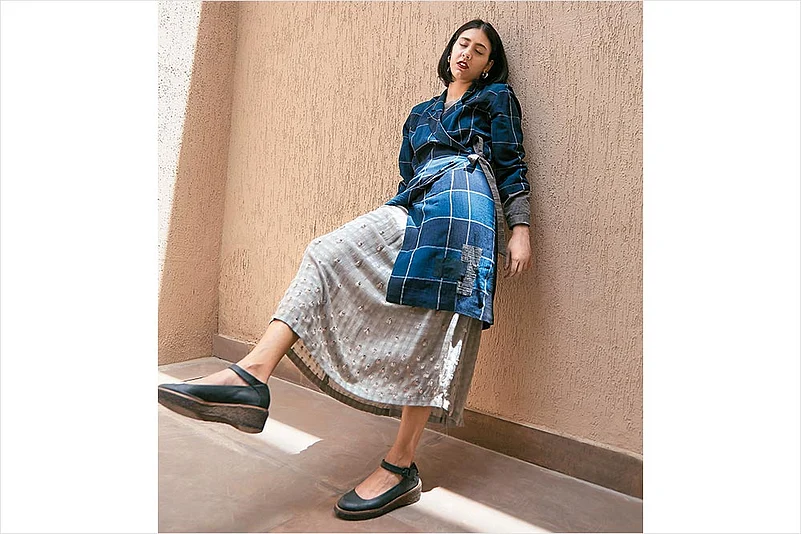Bananas, pineapples, coconuts...no, this isn’t the recipe for a strange, strange fruit salad. Rather, these materials—banana fibre, coconut malai and pi?atex, a fabric made from pineapple—are among the latest high-concept cloth choices in eco-fashion. Banana fibre is, in fact, already employed by sustainable fashion label Doodlage, while malai and pi?atex are high on HR’s waiting list. And that worn-out adage about waste and want may shuffle in one day to find itself installed with pride of place in a -place of the highest honour: when Doodlage founder Kriti Tula shows us a laptop case she’s made for herself, with intricate designs on -ink-blue and indigo waste cloth, it’s hard not to be impressed.
Pizzazz In A Pineapple Frock
Fruity fabrics and ‘waste not, want not’: sustainable -fashion is on the ascendant

Even as industrial waste from textile factories lays waste to the environment, sustainable fashion practices, which aim to have a positive impact through an ethical and meticulous choice of materials and dyes, are slowly marking out a space for themselves. Uttarakhand-born Kriti tells Outlook, “For me, the environment comes before fashion. I am a designer, but my principles are what make my profession. I would either sell clothes that are environmentally sustainable, or not sell them at all. Even the people I hire—I ensure that they care about environment as much as I do”. Sustainability is infused not only in their designs and tailoring, but also in the work culture: “I do not allow plastic bottles or paper cups to be used in my office. We have a kettle that is used for passing around tea, and everybody carries their own mug.” Kriti also works in the belief that a sustainable fashion brand creates more jobs for artisans, due to the craftsmanship involved in these brands.
“When I went to the London College of Fashion for my master’s, I acquired in-depth knowledge about sustainable fashion, and realised how important it was,” adds Kriti, who believes that Doodlage—though it’s early days yet—has been growing prosperously, with exposure at Lakmé fashion weeks, and cel-ebrities like Kalki Koechlin, Dia Mirza and Taapsee Pannu donning it.

Handwoven cotton Jamdani tiered dress with handwoven -organza silk as the -embroidery fringe slip at the hem, by Eka
With the likes of khadi and org-anic silk, India has a history of, perhaps unconscious, sustainable fashion practice—and designers are now being drawn to these materials and to traditional artisans. Rina Singh launched her label, Eka, in 2012. As an undergraduate at the National Institute of Fashion Technology (NIFT), she had travelled ext-ensively in Gujarat, where she immersed herself in Indian crafts, coming to realise the potential of traditional cloth and materials to be sustainable.
Rina’s fashion statement manifests through elusive colours and fluid layers of clothing, shown off by fashion icons like actress Sonam Kapoor. Compared to the materials used and discarded by the ‘fast fashion’ retail industry,? Eka’s organic fabrics like silk and wool are biodegradable and avoid the issue of landfills. Rina also tries not to waste materials that are remnants of other clothing, and engineers this waste to make entirely new outfits. “Commercial success comes second to sustainability. And these are clothes that can sustain for a longer period of time, so there is totally no wastage,” she says. Aiming to create a bridge between craftsman and consumer, Rina employs the artisans who make these clothes. “They spin the yarns, and carpenters make the block patterns. There are so many craftsmen involved in this, which helps in trying to keep in line with the tradition of the country.”
Abraham and Thakore, a more established sustainable fashion label known for their Indo-Western mixes, with black and white as their trademark colours, take a similar approach. “Our fashion is concerned with sustaining the -tra-ditional livelihoods of craftspeople and weavers in our economy, and not only with env-ir-onmental issues—which are equally imp-ortant—as circumstances in India are different from the West’s concerns,” says co-founder David Abraham.? Like Rina’s Eka, Abraham and Thakore use bio-degradable materials such as cotton, linen and wool, and feel strongly that traditional fashion styles should be identified. “We started with the belief that it was necessary to develop a contemporary design language for traditional textile craft in order to find new markets for traditional makers,” says David, adding, “We also hope that we will learn from the mistakes of the West regarding the negative impact of fast fashion.”

100 per cent linen dresses by Eka
Madhura Dutta, executive director of the All India Artisans and Craftworkers Welfare Association (AIACA), points out that artisans are generally employed only for certain collections of the designer or the brand, and are then out of work unless the business module or brand helps them sustain themselves. “This is a major contribution of the Craftmark [AIACA’s label that certifies hand-crafted products] in the fashion world because, in rea-lity, artisans seldom get recognition on the fashion platforms, and the credit usually goes to the designer.”
Awareness is ano-ther issue; Rina says, “Education about sus-tainable fashion is very limited. When I ask youngsters what my brand stands for, they say, “organic”, which is actually not the case. They can’t even define sustainability.” But a recently founded Calcutta institution, the EcoAvid School of Ethical Design Studies (ESEDS), educates its students about ethical fashion practices. Co-founder Aloke Singh says ESEDS focuses on putting the social good at the heart of design to -promote awareness -regarding ethical practices.

A sustainable suit by Abraham and Thakore
Aloke adds, “As a designer and educator, I would like the Indian fashion industry to be perceived by the global audie-nce as a fusion of ancient traditions with 21st-century design language and innovation within fashion and clothing, which comes in the wake of India’s rapid globalisation and economic development. Sustainability through recycling and upcycling in clothing was always an intrinsic part of the Indian household until recently.”
Until recently. Banhi Jha, senior professor at the fashion design department at NIFT, exp-lains: “Globalisation of fashion and quicksilver-like trends create increased levels of asp--i-ration, manifested through rising demand and consumption, which in turn generates fast fashion. The need for sustainable practices in fashion is increasingly becoming an imperative activity and not merely at the periphery of the commercial environment. Slow fashion incorporates a more reflective design approach, using indigenous and natural materials, handcrafted processes, zero-waste design and non-polluting disposal methods.”
Fast fashion may use fewer natural resources than eco-fashion, but, as Ashwini K Aggarwal, professor at the department of textile technology, IIT-Delhi, points out, “Synthetic mat-erials are more durable and hence have a longer life. However, eventually these materials must be disposed of at a landfill—and, being non biodegradable, remain there for a very long time.”
Union environment minister Harsh Vardhan has the last word: “India has a history of low carbon footprints and sustainable lifestyles, which continue among most people in the country. We need to put a check on over-consumptive practices, as an environmentally friendly lifestyle is the answer to most of the problems of climate change. India traditionally has adopted and taught the world the way of sustainable lifestyles.”

























